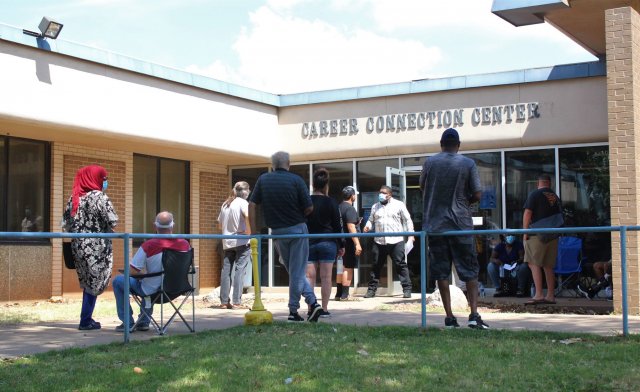
Even as employment rates begin to recover in Oklahoma, thousands of residents with unemployment claims remain trapped on a roller coaster of issues that can take weeks or months to resolve.
The U.S. Bureau of Labor Statistics set Oklahoma’s preliminary unemployment rate for June at 6.6 percent, making the state’s unemployment rate tied for fifth lowest in the country and down six percentage points from May.
But the improving unemployment rates reflect optimism not felt by many Oklahomans waiting on hundreds or thousands of dollars in delayed or missing unemployment benefits.
This story was reported by Gaylord News, a Washington reporting project of the Gaylord College of Journalism and Mass Communication at the University of Oklahoma.
Former U.S. Army Sgt. Ashton Fowler had his last day in the Army on March 12, then filed for unemployment on March 13. He waited a month and a half before his first payment arrived.
“It was supposed to be a quick process,” Fowler said. “But then when the Coronavirus happened, everybody flooded in (…) literally the same week.”
After a month, Fowler’s benefits stopped coming due to an error on his claimant profile. Although he provided information displaying his employment with the Army, Fowler said Oklahoma Employment Security Commission employees labeled him as being in the Navy.
After explaining his situation on the phone with a call agent and being reassured the problem was straightforward to fix, Fowler still had thousands of dollars derailed by a typo.
“When I got here, it was like 7:15 a.m. maybe, and the line was already around the corner,” Fowler said, describing his fourth trip to the Workforce Center in Chickasha.
Fraud flagging can be frustrating
While the issue with Fowler’s claim is unique, his frustration is not.
Many claimants run into trouble when their claim is locked after being wrongly flagged for potentially fraudulent behavior, which has skyrocketed during the pandemic.
“Claims are now and always have been scanned for fraudulent pattern recognition,” said Shelley Zumwalt, the Oklahoma Employment Security Commission’s interim director. “It’s a common deterrent here in this state, but also nationally.”
Around the end of May, benefits froze for Shawnasea Renae, a server working in Norman, Oklahoma. Renae spent two weeks calling and eventually decided to visit the employment commission in person at the Will Rogers Building in Oklahoma City, she said.
“It’s just super stressful when I’m not working for reasons that I cannot control. The people that say, ‘Hey, we’re here to help,’ are literally nonexistent to help, unless you sit in their office,” Renae said. “I’m frustrated that it took so long with so little contact with them.”
Renae arrived 10 minutes after the office opened and waited nearly six hours to discover her claim had been flagged for fraud and the office needed to verify her identity.
“I got to the point where I was (…) eating ramen every day, because I literally cannot afford to go get groceries, because I put gas in my car,” she said. “I was so stressed out.”
Although Zumwalt said a relatively small portion of the 89,000 claims identified as potentially fraudulent are wrongly flagged, she acknowledges the frustration felt by those affected.
“We’re obviously going to err on the side of being over protective as opposed to under,” Zumwalt said.
Claim issues are generally not addressed until a claimant can speak to a claim agent on the phone or in person. Doing so often requires waiting on hold for several hours or spending a long day in a workforce center line. The OESC has hosted several large-scale events to draw down the overall backlog of pending claims.
While many claim issues can be solved by simple overrides or data entry by a claim agent, getting access to that help is the bulk of the battle for claimants.
“I know that it is, you know, super annoying for people that it happens to, and it’s definitely not ideal given everything they’ve been through,” Zumwalt said. “But (…) if we see activity that looks like a fraudulent act, we do have to flag on our end just to make sure that it is a legitimate claim.”






















